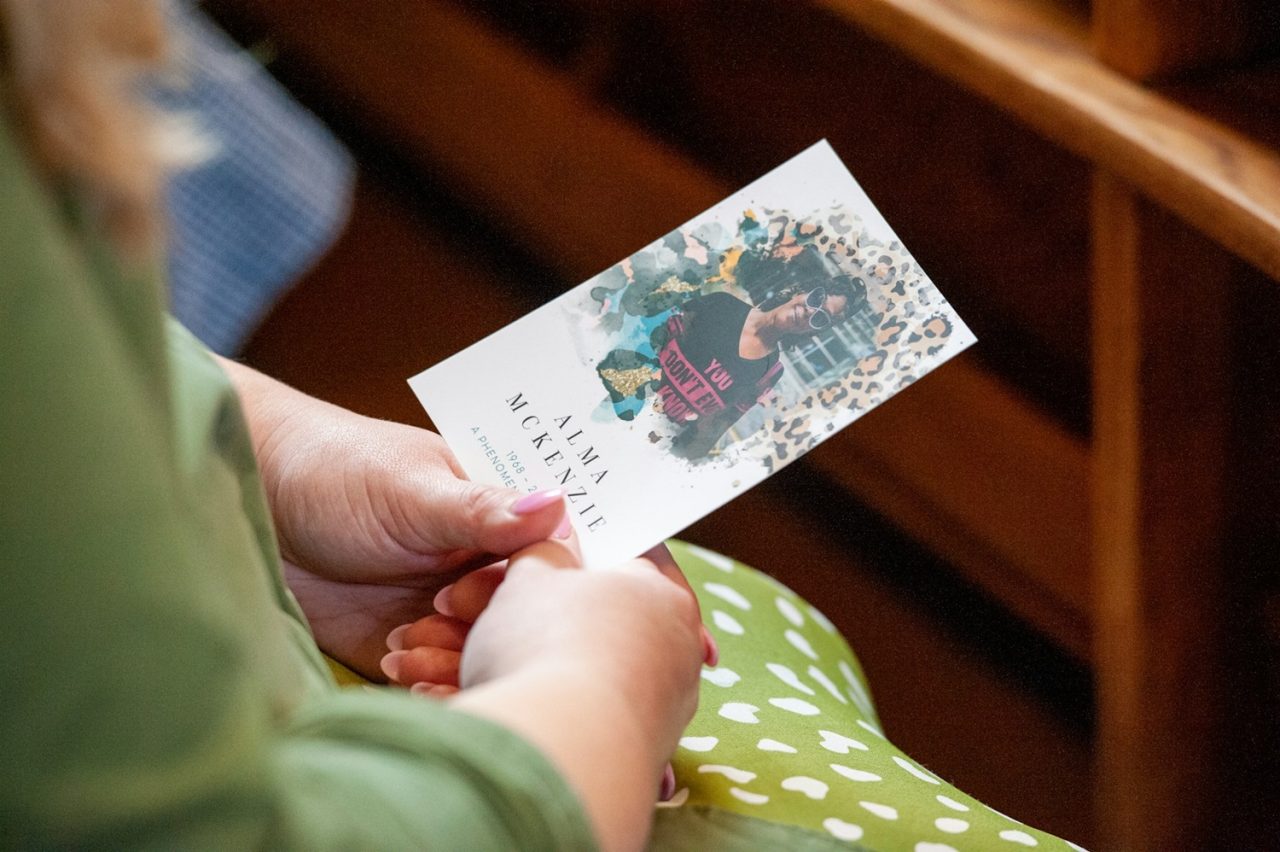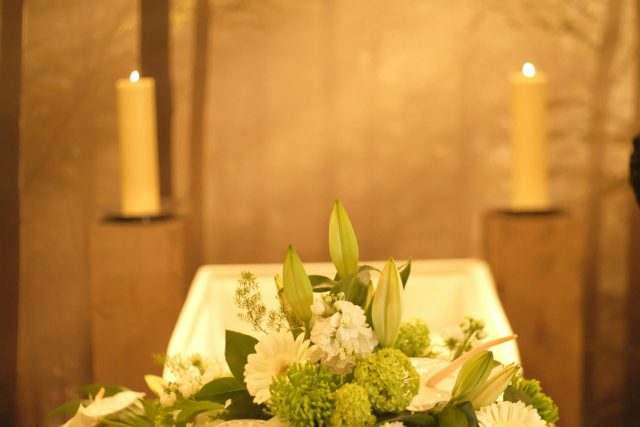
Planning a funeral is never easy. During such a painful and emotional time, even the smallest of decisions can feel overwhelming. One of the many elements to consider is the order of service – the running schedule of the ceremony, often printed in a booklet and shared with those attending.
While it may seem like a small detail, the order of service can play a meaningful role in honouring a loved one’s life.
At Jamieson Funeral Directors, we understand how important it is for families to feel supported as they navigate these choices. The order of service is more than a list of events. It’s a thoughtful way to celebrate memories, share stories and bring people together in remembrance.
In this blog, we’ll guide you through what to include in an order of service, how to personalise it, and ideas that might help you create a fitting and heartfelt tribute.
What is a funeral order of service?
A funeral order of service usually refers to two things: the printed booklet handed out during the ceremony and the schedule or structure of the service itself. It acts as a guide for those attending, giving them a clear understanding of what will happen and when.
More than just practical, it’s also a keepsake. Families and friends often take these booklets home as a way to remember the day and the person they came to honour. Some people even include photographs, readings or favourite quotes to make it all the more personal.
Whether you are planning a religious service, a humanist ceremony or something entirely unique, the order of service can be tailored to suit your loved one’s beliefs, personality and the tone you want to set for the day.
Key elements to include in a traditional order of service
While every funeral is different, there are some common elements that often form the foundation of a typical order of service. These can be adapted as needed, depending on your wishes:
- Welcome or introduction – Usually led by a minister, celebrant or family member, this sets the tone for the service.
- Entrance music – A chosen piece of music as the coffin enters or the mourners gather.
- Readings or poems – These might be religious texts, literary passages or favourite poems that reflect the life of the person being remembered.
- Eulogy or tribute – A personal speech that shares memories, stories and celebrates the life of your loved one.
- Prayers or blessings – If the service is religious, this may include formal prayers, hymns or blessings.
- Moment of reflection – Sometimes accompanied by quiet music or silence, this allows everyone time to think, remember and reflect.
- Committal – The part of the ceremony where final goodbyes are said, particularly at a burial or cremation.
- Exit music – A final piece of music as attendees leave, often uplifting or meaningful.
These elements can be rearranged, simplified or expanded upon to create a service that feels just right for your family.
Personal touches to make it meaningful
Adding personal elements to the order of service can bring warmth, comfort and individuality to the ceremony. These small touches help reflect the personality and passions of the person being remembered.
For example, you might choose entrance or exit music that was a favourite song, a track from a cherished holiday or something with lyrics that carry special meaning.
Readings could come from a beloved book or a poem they often quoted – or perhaps from a hobby they loved, such as these poems for gardeners.
If your loved one had a sense of humour, consider a light-hearted anecdote in the eulogy – laughter can be a healing part of saying goodbye.
Some families like to invite guests to participate by reading a poem, lighting a candle or sharing a memory during the service. You can also include personal photographs in the printed booklet, a short biography or a timeline of their life highlighting key events and achievements.
Even simple ideas, like using a meaningful colour scheme or printing a favourite quote on the back cover, can help make the day feel more personal and memorable.
Creative ideas for modern or alternative services
Not every funeral follows a traditional format. Many families now choose to create a more relaxed or informal farewell that better reflects their loved one’s life and values. The order of service can be tailored accordingly.
If the ceremony is led by a celebrant or held in a non-religious setting, you might include a mix of storytelling, music and visual tributes such as a photo slideshow. Some families opt for live music – a local choir, a favourite band or even family members performing – which can be mentioned and timed in the service programme.
For nature lovers, an outdoor service might feature readings by trees or water, and guests may be invited to place flowers or messages during a moment of reflection. For those with strong community ties, you could include space for multiple speakers to share memories, creating a sense of shared remembrance.
There is no need to stick rigidly to tradition. The most meaningful services are often those that reflect the unique character of the person being honoured – even in small and simple ways.
Tips for preparing and printing the booklet
Once you’ve planned the structure of the service, the next step is preparing the printed order of service booklet. This not only acts as a guide on the day but also becomes a lasting memento for those attending.
Here are some useful tips to keep in mind:
- Keep it clear and simple – A clean layout and readable fonts help guests follow the ceremony easily.
- Include key details – Full name, dates of birth and passing, date and location of the service.
- Use photos thoughtfully – A single image on the cover or a collage of special memories inside can add a personal touch.
- Thank attendees – A short thank-you note or mention of refreshments afterwards can be a kind gesture.
- Donation details – If you are requesting charitable donations in lieu of flowers, include this information near the end.
- Ask for help if needed – Funeral directors like Jamieson can support you with layout, printing and delivery, making the process less stressful at an already difficult time.
In celebration and remembrance
When it comes to creating the order of service for a funeral, there’s no one-size-fits-all approach. What matters most is that the ceremony feels authentic, comforting and reflective of the person you’re saying goodbye to.
Whether you choose a traditional format or something more modern and personal, remember that it’s okay to keep things simple. Sometimes the smallest gestures – a familiar song, a cherished photo, a few heartfelt words – speak volumes.
Support from Jamieson Funeral Directors
When you’re making decisions about your loved one’s farewell, Jamieson Funeral Directors is here to help. From helping you plan the order of service to supporting you through every detail, we’re here with compassion and care. Reach out to us at directors@jamiesonfuneraldirectors.co.uk or call 0117 956 4796. We’re available 24 hours a day.
Related FAQs
- 7 Touching Memorial Poems for Grandad’s FuneralSaying goodbye to a beloved grandad is never easy. Whether he was a gentle storyteller, a steady hand through life’s ups and downs or the heart of the family, the… Read more: 7 Touching Memorial Poems for Grandad’s Funeral
- Can You Attend a Direct Cremation?Direct cremation has grown in popularity in recent years, especially for those looking for a simpler, more cost-effective alternative to a traditional funeral. With no formal service, no procession and… Read more: Can You Attend a Direct Cremation?
- 25 Memorial Plaque Ideas to Honour a Loved OneChoosing a memorial plaque is a tender and significant part of remembering someone you love. Whether it’s placed beside a grave, in a peaceful garden or on a favourite bench,… Read more: 25 Memorial Plaque Ideas to Honour a Loved One




